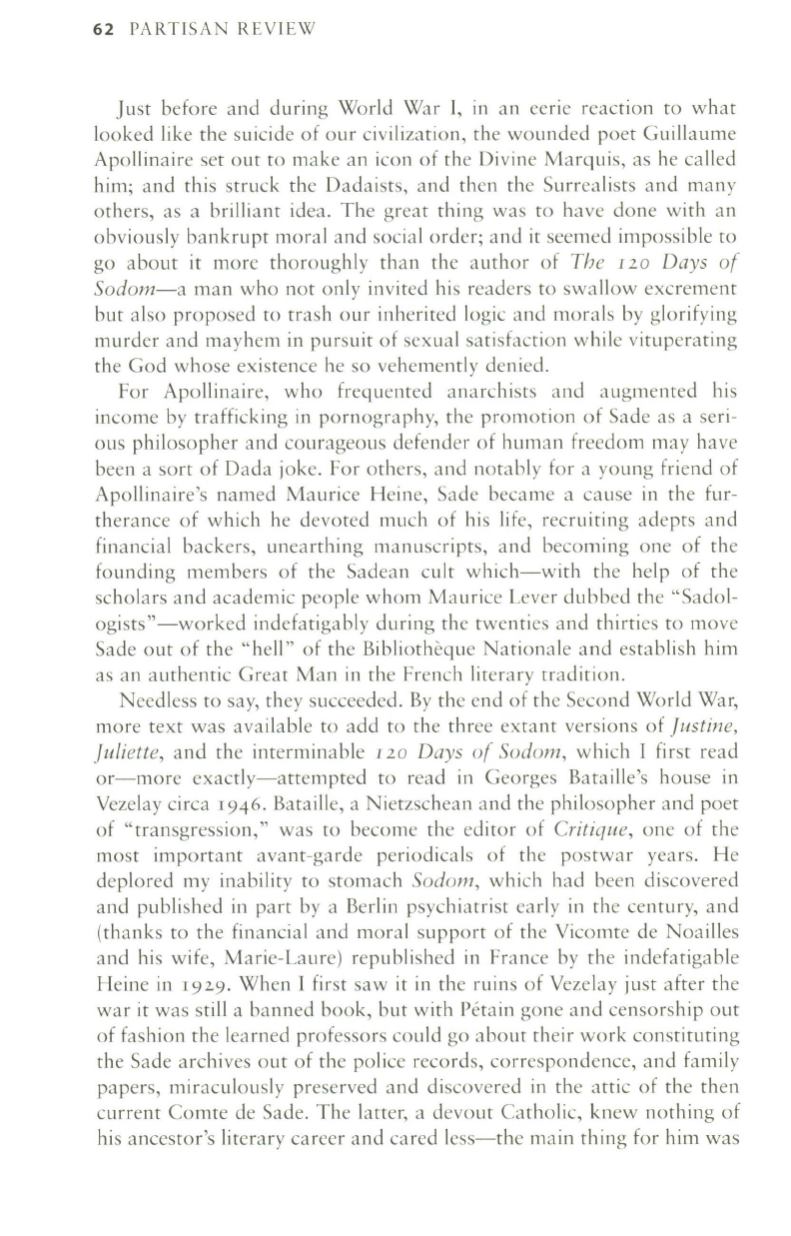
62
PARTISAN REVIEW
Just before and during World War 1, in an eerie reaction to what
looked like the suicide of our civilization, the wounded poet Guillaume
Apollinaire set out to make an icon of the Divine Marquis, as he called
him; and this struck tbe Dadaists, and then the Surrealists and many
others, as a brilliant idea. The great thing was to have done with an
obviously bankrupt moral and social order; and it seemed impossible to
go about it more tboroughly than the author of
The
L20
Days of
Sodom-a
man who not only invited his readers to swallow excrement
but also proposed to trash our inherited logic and morals by glorifying
murder and mayhem in pursuit of sexual satisfaction while vituperating
the God whose existence he so vehemently denied.
For Apollinaire, who frequented anarchists and augmented his
income by trafficking in pornography, the promotion of Sade as a seri–
ous philosopher and courageous defender of human freedom may have
been a sort of Dada joke. For others, and notably for a young friend of
Apollinaire's named Maurice Heine, Sade became a cause in the fur–
therance of which he devoted much of his life, recruiting adepts and
financial backers, unearthing manuscripts, and becoming one of the
founding members of the Sadean cult which-with the help of the
scholars and academic people whom Maurice Lever dubbed the "Sadol–
ogists"-worked indefatigably during the twenties and thirties to move
Sade out of the "hell" of the Bibliotheque Nationale and establish him
as an authentic Great Man in the French literary tradition.
Needless to say, they succeeded. By the end of the Second World War,
more text was available to add to the three extant versions of
justine,
juliette,
and the interminable
120
Days of Sodom,
which I first read
or-more exactly-attempted to read in Georges Bataille's house in
Vezelay circa
1946.
Bataille, a Nietzschean and the philosopher and poet
of "transgression," was to become the editor of
Critique,
one of the
most important avant-garde periodicals of the postwar years. He
deplored my inability to stomach
Sodom,
which had been discovered
and published in part by a Berlin psychiatrist early in the century, and
(thanks to the financial and moral support of the Vicomte de Noailles
and his wife, Marie-Laure) republished in France by the indefatigable
Heine in
1929.
When I first saw it in the ruins of Vezelay just after the
war it was still a banned book, but with Petain gone and censorship out
of fashion the learned professors could go aboLit their work constituting
the Sade archives out of the police records, correspondence, and family
papers, miraculously preserved and discovered in the attic of the then
current Comte de Sade. The latter, a devout Catholic, knew nothing of
his ancestor's literary career and cared less-the main thing for him was


